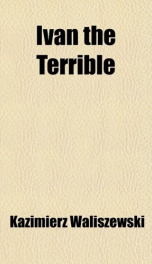ivan the terrible

Purchase of this book includes free trial access to www.million-books.com where you can read more than a million books for free. This is an OCR edition with typos. Excerpt from book: CHAPTER IV HABITS AND CUSTOMS I. THEIR ASPECT, PHYSICAL AND MORAL. II.THE WOMEN. III. THE FAMILY. IV.SOCIETY. I.Their Aspect, Physical And Moral. The thirteenth-century invaders did not prevent all civilization in Russia ; in fact, they imposed their own civilization on the country, and, to judge by the consequences, this side of their conquest was far-reaching. Look at the Muscovite of the sixteenth century. To begin with, he is dressed from head to foot after the fashions of Samarkand. Bachmak, iazam, armiak, ziponne, tchebygi, kaftane, outchkour, chlyk, bachlyk, kolpak, klobouk, taflia, temlakall these are the Tartar names he applies to the various items of his attire. If he falls out with his comrades, and begins to use rough language, the word dourak invariably occurs in his vocabulary ; if he comes to blows, the koulak straightway appears. When he metes out justice, he binds the culprit with kandaly (chains), and appeals to the kate (executioner) to give the condemned man the knout. If he is an official he gathers the taxes into a kazna (treasury), protected by a karaoul (guard-house), or organizes relays which he calls iamy on roads served by iamchtchiki. When he gets out of his posting-sleigh, he is seen going into a kabak (tavern), which has taken the place of the old Russian kortchma. And all these words belong to the same Asiatic dictionary. The meaning of all this, though it affects external matters only, is surely very significant. A more serious thing is that a certain infusion of Mongol blood seems to have accompanied this prompt and docile assimilation. What was its extent ? It is difficult to decide. Russian documents dealing with the subject are non-existent, and the observations of foreign travellers contradict each other. ' The real Muscovite n...
Info about the book
Author:
Series:
Unknown
ISBN:
1164943391
Rating:
4/5 (3)Your rating:
0/5
Languge:
English
Users who have this book
Users who want this book
What readers are saying
What do you think? Write your own comment on this book!
write a commentif you like ivan the terrible try:
Other books by this author
Do you want to read a book that interests you? It’s EASY!
Create an account and send a request for reading to other users on the Webpage of the book!


